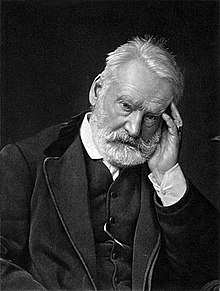Victor Hugo in 1877

Victor Hugo in 1877 – sonet[1][2][3][4] angielskiego poety Algernona Charlesa Swinburne’a[5][6][7][8], opublikowany w tomiku Poems and Ballads. Second Series, wydanym w Londynie w 1878 roku przez spółkę wydawniczą Chatto & Windus i wznowionym w Nowym Yorku w 1885. Wiersz jest poświęcony francuskiemu poecie, prozaikowi i dramaturgowi, a także działaczowi na rzecz demokracji republikańskiej, Wiktorowi Hugo[9][10], którego Swinburne wysoko cenił[11][12][13]. Utwór jest napisany pentametrem jambicznym[14] i rymuje się abba abba cddcee. Jest to więc sonet francuski[4].
- Above the spring‑tide sundawn of the year,
- A sunlike star, not born of day or night,
- Filled the fair heaven of spring with heavenlier light,
- Made of all ages orbed in one sole sphere
- Whose light was as a Titan's smile or tear;
- Then rose a ray more flowerlike, starry white,
- Like a child's eye grown lovelier with delight,
- Sweet as a child's heart‑lightening laugh to hear;
- And last a fire from heaven, a fiery rain
- As of God's wrath on the unclean cities, fell
- And lit the shuddering shades of half‑seen hell
- That shrank before it and were cloven in twain;
- A beacon fired by lightning, whence all time
- Sees red the bare black ruins of a crime.
Swinburne był z przekonań demokratą i w swojej twórczości dawał wyraz swoim poglądom, pisząc wiersze między innymi dla Giuseppe’a Mazziniego i Lajosa Kossutha. Gloryfikował też Giuseppe’a Garibaldiego, przywódcę ruchu zjednoczenia Włoch[15]. Zobacz też: The Statue of Victor Hugo, To Victor Hugo
Przypisy
[edytuj | edytuj kod]- ↑ sonnet, [w:] Encyclopædia Britannica [dostęp 2017-03-17] (ang.).
- ↑ The Sonnet: Poetic Form. poets.org. [dostęp 2017-03-17]. (ang.).
- ↑ sonet, [w:] Encyklopedia PWN [online], Wydawnictwo Naukowe PWN [dostęp 2017-03-17].
- ↑ a b Wiktor Jarosław Darasz: Mały przewodnik po wierszu polskim. Kraków: Towarzystwo Milośników Języka Polskiego, 2003, s. 156-161. ISBN 83-900829-6-9.
- ↑ Algernon Charles Swinburne, [w:] Encyclopædia Britannica [dostęp 2017-03-16] (ang.).
- ↑ Algernon Charles Swinburne, Poet (1837–1909). PoetryFoundation.org. [dostęp 2017-03-16]. (ang.).
- ↑ Glenn Everett: A. C. Swinburne: Biography. victorianweb.org. [dostęp 2017-03-16]. (ang.).
- ↑ Swinburne Algernon Charles, [w:] Encyklopedia PWN [online], Wydawnictwo Naukowe PWN [dostęp 2017-03-16].
- ↑ Victor Hugo, [w:] Encyclopædia Britannica [dostęp 2017-03-17] (ang.).
- ↑ Hugo Victor Marie, [w:] Encyklopedia PWN [online], Wydawnictwo Naukowe PWN [dostęp 2017-03-17].
- ↑ John Andrew Frey: A Victor Hugo Encyclopedia. books.google.pl, 1999. s. 253. [dostęp 2017-03-17]. (ang.).
- ↑ When Algernon Swinburne met Victor Hugo. independent.co.uk. [dostęp 2017-03-17]. (ang.).
- ↑ Thomas E. Connolly: Swinburne's Theory of the End of Art. jstor.org, 1952. [dostęp 2017-03-17]. (ang.).
- ↑ Iambic Pentameter. shakespeareinamericancommunities.org. [dostęp 2017-03-17]. (ang.).
- ↑ Przemysław Mroczkowski: Historia literatury angielskiej. Zarys. Wrocław: Ossolineum, 1981, s. 441. ISBN 83-04-00784-3.
Bibliografia
[edytuj | edytuj kod]- Algernon Charles Swinburne: Poems and Ballads. Second Series. Archive.org, 1908. [dostęp 2017-03-16]. (ang.).
- Algernon Charles Swinburne: Poems & Ballads, Second & Third Series. Archive.org, 1902. [dostęp 2017-03-16]. (ang.).
Linki zewnętrzne
[edytuj | edytuj kod]- Algernon Charles Swinburne: Victor Hugo in 1877. monadnock.net. [dostęp 2017-03-17]. (ang.).
